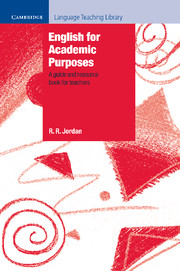Book contents
- Frontmatter
- Contents
- List of figures
- List of abbreviations
- Acknowledgements
- Introduction
- Part I English for Academic Purposes and study skills
- Part II Study skills and practice (EGAP)
- Part III English for Specific Academic Purposes
- Chapter 16 Academic discourse and style
- Chapter 17 Subject-specific language
- Chapter 18 Materials design and production
- Chapter 19 Concerns and research
- Appendices
- References
- Subject index
- Author index
Chapter 17 - Subject-specific language
Published online by Cambridge University Press: 10 November 2010
- Frontmatter
- Contents
- List of figures
- List of abbreviations
- Acknowledgements
- Introduction
- Part I English for Academic Purposes and study skills
- Part II Study skills and practice (EGAP)
- Part III English for Specific Academic Purposes
- Chapter 16 Academic discourse and style
- Chapter 17 Subject-specific language
- Chapter 18 Materials design and production
- Chapter 19 Concerns and research
- Appendices
- References
- Subject index
- Author index
Summary
We must not lose sight of the fact that students do not study EAP for general purposes but to equip themselves with the necessary tools to study specific academic subjects. They may be studying one discipline or, more likely, combined subjects: they will, thus, encounter a variety of academic sub-genres. It is for this reason that there are often specific components or options within an EAP course, or even the entire course, devoted to particular disciplines or subjects.
The purpose of this chapter is to draw some threads together that have been referred to in earlier chapters that relate to ESAP: in particular, how aspects of ESAP may be taught by EAP teachers, and the kinds of activities that are feasible. We must bear in mind that on EAP courses time is limited, i.e. what is the most efficient way to utilise the time? How can students be helped best? What are teachers capable of achieving? What considerations need to be addressed?
Regarding a possible conflict of interests between EGAP and ESAP, Johns' (1988a) observation is relevant:
the differences between the skills and conventions needed in academia may be greater than the similarities; for discipline, audience and context significantly influence the language required. Students must therefore readjust somewhat to each academic discipline they encounter.
The situation, as it affects teachers and students, can be summarised diagrammatically, with EGAP as the base and ESAP the pinnacle (see Figure 20).
- Type
- Chapter
- Information
- English for Academic PurposesA Guide and Resource Book for Teachers, pp. 249 - 258Publisher: Cambridge University PressPrint publication year: 1997
- 1
- Cited by



